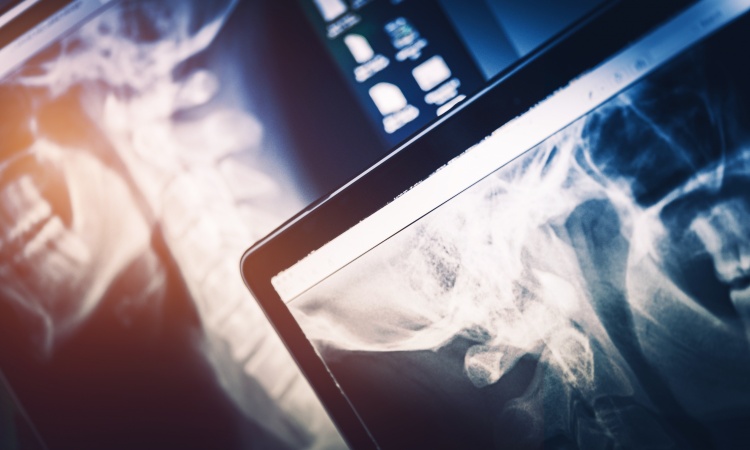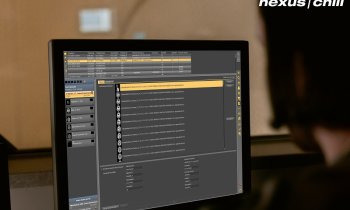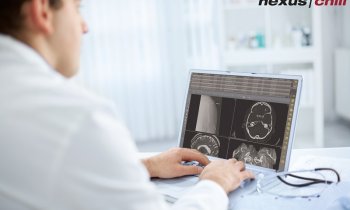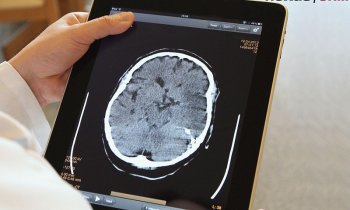Next-generation medical IT Systems
Radiologist Henrik E Gregersen MD, of Aalborg University Hospital, Denmark,
Pervasive, mobile, and here today - a report on groundbreaking developments for diagnostic readings of CT, MR, and CR examinations on wireless PDAs.
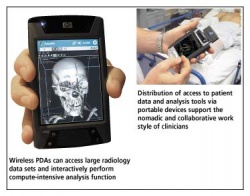
Imagine a clinician standing beside a patient on a ward and evaluating the patient’s 500 slice CT scan interactively and online, using a wireless personal digital assistant (PDA). A fantasy, right? But why should it be so difficult to distribute radiological images throughout a hospital, or even outside the facility?
The Challenge and the Vision - For years this scenario has been the dream of radiologists at Aalborg University Hospital, Denmark.
Aalborg is a multi-site research and teaching hospital. With 900 beds it produces 130,000 radiological examinations annually. A main challenge for the radiology department has been managing data from the four radiology units that are scattered within a radius of 30 km. Even with high-speed and high-bandwidths networks, it is troublesome to view and evaluate large exams, particularly from multi-slice CT scanners. One solution has been to distribute image data via a web-based system, which is a slow process and often results in considerable image degradation due to lossy compression methods. Another solution has been to install a large PACS system that sends (pre-fetches) exams to various centrally-placed workstations on wards or in the radiology units.
Radiologists have also acknowledged that modern computing systems, such as workstations, PCs and laptops are not suitable for the nomadic and collaborative working styles of clinicians and radiologists. Logging in and out of computers is wearisome and time consuming, and there is always the need to find the nearest suitable computer.
So, the vision at Aalborg has been to find a way to easily distribute data wirelessly, on truly portable devices, with the confidence that this should make clinical staff more mobile and efficient, thus improving patient care.
The Solution - Several years ago, Medical Insight A/S, a Danish software company, presented a next-generation medical IT system to the hospital. The solution was a PACS/RIS system coupled with a unique streaming technology. It immediately became apparent that here was a truly mobile and efficient tool for distribution of data, which could provide the same performance and functionality on all devices, from large workstations to wireless PDAs.
In mid-2002 a pilot system was installed at Aalborg University Hospital and was well received. In the beginning only the main radiology department was wireless, but today wireless access is widely available. By the end of 2005, the PACS/RIS system, with streaming, will be installed in all departments of the 11 hospitals in the County of North Jutland. The County’s Healthcare IT Department has developed an infrastructure for wireless devices that efficiently keeps all 1,100 PDAs updated and running, giving clinicians constant access to resources, reference materials, and radiology reports and data (in full fidelity).
The system, from Medical Insight, is a fully integrated PACS and RIS product for image and data management that is easy-to-use and provides standard and specialised modules to support various types of clinical analyses. Based on a client-server architecture, central Linux cluster servers contain all data and applications, and client devices access the data and power of the servers via streaming methods. This allows light clients such as PDAs, PCs, and laptops to access large data sets in seconds and in full-resolution, and to interactively view the data, even in 3D, over standard and wireless connections. No data are transmitted to light clients for processing - all computing is done on the servers, and only final screen images are streamed to clients based upon user interaction requests.
Real Experiences - At the 2005 European Congress of Radiology, radiologists Henrik Gregersen and Geert Willander from Aalborg University Hospital presented the results of a groundbreaking study that showed diagnostic readings were possible on wireless PDAs for CT, MR, and CR exams of orthopaedic cases. Due to the PDA’s small screen size, extra interactions with the images were required (pan, scroll, zoom), but the full-resolution and full-fidelity data proved suitable for diagnosis. More comprehensive studies are continuing.
One drawback of PDAs is the relatively short battery life, which makes it impossible to work an entire day without recharging. However, new industrial-grade PDAs claim long battery life and protection against drop damages.
In summary, the use of PDAs for wireless access to patient data and analysis tools is growing in the County of North Jutland and elsewhere. Radiologists and clinicians are starting to benefit from the new technology - radiology images and reports are accessible online, on time, and on-site in the same manner as in the radiology department. Thus, the vision is being realised - greater staff mobility and full access to tools and data are generating faster evaluations, better quality patient information, and more efficient diagnoses and treatments.
07.08.2006





